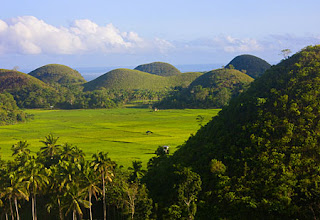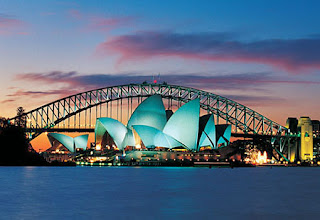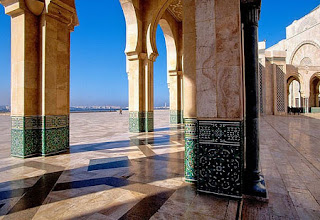Beautiful Beaches around the World
Filed under by Nahal Ahmed on 11:24 PM










 Operating system is a core set of programs that control and supervise the hardware of a computer and provides services of a computer. Operating system tells the computer how to interact with the user and how to use devices such as Disks, Keyboard , Mouse and Printer.
Operating system is a core set of programs that control and supervise the hardware of a computer and provides services of a computer. Operating system tells the computer how to interact with the user and how to use devices such as Disks, Keyboard , Mouse and Printer.

They say that truth is stranger than fiction — and you could argue just as strongly that Mother Nature comes up with much more bizarre stuff than we ever could. Here are just a few of Earth's weirder wonders.
Just getting to


The island of Bohol is home to hundreds and hundreds of closely clustered limestone domes called the Chocolate Hills because of their carpet of grass, which turns brown in the dry season. Scientists aren’t sure how they formed, but hopefully it wasn’t due to a giant water buffalo that got a bad case of food poisoning, as one local legend holds.

If you think the Great Salt Lake is salty, head a little ways west and checks out the Bonneville. This 30,000-acre area is encrusted with a layer of salt up to five feet thick, the leftovers from a Pleistocene-era lake that covered parts of three states. It's estimated that the salt flats hold 147 million tons of salt, enough to keep your shaker filled for quite awhile.

Shilin translates to “stone forest,” and this set of karst formations in southwestern China’s Yunnan Province really does look like a forest of stone. The stone pinnacles, some of which reach nearly 100 feet toward the sky, are believed to be more than 270 million years old. Visiting after sunset is an especially unearthly experience.
 Remarkable rock formations are plentiful in Abel Tasman National Park on New Zealand's South Island, but none is weirder than Split Apple Rock, rising from the water of Tasman Bay. The giant boulder has been broken in two pieces so cleanly that it’s almost as if a giant hit it with an ax.
Remarkable rock formations are plentiful in Abel Tasman National Park on New Zealand's South Island, but none is weirder than Split Apple Rock, rising from the water of Tasman Bay. The giant boulder has been broken in two pieces so cleanly that it’s almost as if a giant hit it with an ax.

Curved arches, exquisite tiling, skylights — in a

One of the world’s newest underground experiences — the tour debuted in October 2010 — is a place where no one went enthusiastically two millennia ago: the underground chambers of Rome’sColosseum. It was here, after all, that slaves were kept before being forced to fight for their lives in front of enthusiastic audiences.

This secret command center, used by the British Cabinet during World War II, was set in the cellar of

The only outstanding Titan missile silo still has a defanged missile in its launch duct. Visitors to this museum can view it, along with a control room in which everything is mounted on springs to reduce spoil should a missile land nearby. If you plan well in advance you can appeal to bunk here overnight, just feet away from the warhead.
 A UNESCO World Heritage Site, this nine-story hole in the ground is home to superb statues, bas relief and full chapels carved out of salt by miners over the centuries. The mine goes down nearly 1,000 feet and includes a massive salt lake at its heart.
A UNESCO World Heritage Site, this nine-story hole in the ground is home to superb statues, bas relief and full chapels carved out of salt by miners over the centuries. The mine goes down nearly 1,000 feet and includes a massive salt lake at its heart.

There are perhaps two candidates for the title of world's greatest current footballer. One is the swaggering, arrogant Cristiano Ronaldo, and the other is a man you might walk past in the car park.
Lionel Messi's sublime skills are balanced by modesty and humility. You're as likely to catch him chatting to
Wayne Gretzky

Ice hockey star Wayne Gretzky is generally regarded as the greatest player in the history of the NHL. He is the only NHL player to total over 200 points (goals plus assists) in a single season.
But despite his massive talent, Gretzky was never less than a team player. When he retired in 1999, his statement made no mention of his individual achievements, legend though they were, but only of his love for the sport. His charity work continues to this day.
Ryan Giggs

Fans of other teams may scoff, but another Manchester United player surely deserves a place in any list of humble footballers.
Ryan Giggs has a list of achievements as long as his arm, and early in his career looked to be going down the David Beckham road to international fame. But then he switched lanes, shunning parties and celebrity girlfriends and focusing on football.
In 2007 he married his long-term partner in a ceremony notable for the absence of OK! And Hello! Magazines and today he lives quietly in
Drew Brees

Drew Brees, quarterback for the New Orleans Saints, was recently voted Sports Illustrated sportsman of the year. That was for a wonderful season on the pitch - Brees led the Saints to their first Super Bowl title in February 2010 - and a truly inspirational one off it.
Brees joined the Saints just after Hurricane Katrina in 2006, and was moved by the plight of the battered city. Since then his foundation has worked with nearly 50
Paul Scholes

Compared to some of his more stellar contemporaries, it's easy to forget the humble family man who retired from international football in 2004 and won't do a media interview unless Manchester United make him. Paul Scholes is a one-club player who has never agitated for a move and doesn't even employ an agent.
Scholes has a touch of steel about him - some of his two-footed tackles leave a lot to be desired - but in a world full of celebrity footballers, he is a man of immense talent and few pretensions.

The best way to participate in the growth of emerging economies may be to hold blue-chip multinational companies -- no matter where they are based.
"Where a stock is listed is becoming almost irrelevant," says Sarah Ketterer, co-manager of Causeway Global Value Fund (CGVIX).
At Causeway and elsewhere, money managers and analysts who spent careers following
"To make good stock decisions, you'd better have a global perspective," says Bob Turner, co-manager of Turner Core Growth Fund (TTMEX).
What matters is not where a company is headquartered but where it generates its revenues and profits, and where its growth opportunities lie. Tobacco giant Philip Morris International is based in
We assembled a list of 10 companies -- five based in the
Peter Baughan, co-manager of the Harding Loevner Global Equity Fund (HLMVX) identifies companies that tap into long-term-growth themes. He's found one such theme in diabetes, a disease that is reaching epidemic proportions worldwide. Baughan's play on this disease is Novo Nordisk (NVO, news), the leader in diabetes care with just over half of the global market for insulin.
By the end of this decade, half of all adult Americans will be diabetic or pre-diabetic unless they change their diets and lose weight, according to UnitedHealth Group. The incidence of diabetes is also exploding in
Unlike its diversified competitors in the synthetic-insulin business, Novo Nordisk benefits from its laser focus on diabetes. It plows 15% of annual sales into research, which leads to contraptions such as pen-delivery systems for insulin and new drugs such as Victoza, a once-a-day insulin shot that also promotes weight loss.
The grim economic news from
With a powerful global brand, Canon generates about 80% of its sales outside of
Canon has $9 billion of cash on its balance sheet and no debt. The
When you combine superb engineering with ruthless cost cutting, you create a formidable competitor. That's the story of venerable Siemens (SI, news), a lumbering giant no more.
"Siemens is going through the greatest transformation since the beginning of the company, 163 years ago," says David Marcus, the manager of Evermore Global Value Fund (EVGIX).
Siemens' decision to reduce head count, close plants and exit businesses in which it's not the No. 1 or No. 2 player accelerated when Peter Löscher became the chief executive in 2007. "Löscher makes changes, not excuses," says Marcus. Productivity and profit margins are surging, and earnings are up despite modest sales growth.
Siemens is a global force in industrial-automation, power-generation and transportation equipment. In the quarter that ended Sept. 30, the company landed orders to supply Amtrak with 70 locomotives and to build a steel mill in
Over the past five years, revenues from emerging markets have risen from 19% to 30% of sales (
If you're a purveyor of food, beverages, toothpaste or shampoo, developing nations are where the growth is. You can tap into that demand with Coca-Cola(KO, news), which blankets the globe. Or you can focus on fast-growing Latin American countries by investing in Coca-Cola Femsa (KOF, news), the largest bottler of Coca-Cola products outside the
"Coke Femsa is a great way to play consumer spending in emerging markets," says Evermore's Marcus.
Coca-Cola Femsa, 32% owned by Coca-Cola, already dominates in
The bottler, which accounts for 10% of Coca-Cola's global volume, recently entered a joint venture with the
Marcus thinks that Coca-Cola Femsa, known as an excellent operator, will be a large beneficiary of the parent company's push to consolidate its bottling operations.
When you mix
In the first half of Richemont's fiscal year, which ended Sept. 30, sales in the Asia-Pacific region, excluding
Controlled and run by Johann Rupert, a low-profile South African, Richemont establishes a retail presence for its luxury brands wherever wealth is minted. Says David Winters of Wintergreen Fund (WGRNX, news): "When people get richer, they like to look sharp and adorn themselves with baubles that say 'Look at me. I'm a success.'"
Winters says that Richemont's accounting is conservative, and he expects earnings to climb at an annual rate of about 15% for years to come.
The steady stream of imaginative products from Apple has redefined industries and made competitors such as Microsoft and Sony look slow. (Microsoft is the publisher of MSN Money.) The key questions about the stock are whether a company as large as Apple can keep growing at its breakneck pace, especially with co-founder Steve Jobs on a medical leave of absence, and whether the shares still offer value after a 58% run-up over the past 12 months.
The
"People are underestimating the potential of tablets, which are a transformational event in computing," says Turner, who thinks Apple could earn $21 a share in the fiscal year that ends next September, about 8% more than analysts' average forecast. If he's right, and if you deduct the company's cash pile from the stock's price, Apple can be considered cheap for a high-quality company expected to generate earnings growth of 20% a year over the next three to five years.
Business looks good at Walt Disney on both a cyclical and a long-term basis. Consumers are spending in its theme parks and on its cruise ships. TV ad rates are rising, the company's movie studio is turning out hits such as "Toy Story 3", the first animated film to gross $1 billion, and its sports-TV juggernaut, ESPN, is immensely profitable.
"The ESPN franchise cannot be replicated," says Cory Gilchrist, co-manager of Marsico Global Fund. "Live sports are the one thing people want to watch on large-screen TVs with friends."
Disney has demonstrated an ability to push unique, iconic content to growing global audiences through broadcasting outlets and over the Internet. "Content will be king," says Jerry Jordan of the Jordan Opportunity Fund
The
MasterCard, like rival Visa, processes credit and debit transactions. Like a toll collector, MasterCard extracts a percentage of each electronic payment. Unlike the bank that issues the card, MasterCard assumes no credit risk. Of course, it can suffer if the number of transactions declines.
MasterCard's growth comes from the inexorable shift from cash to electronic transactions around the globe. The
Visa and MasterCard benefit from the network effect: The more cards they have outstanding, and the more merchants and financial institutions in their global-payments networks, the more difficult it is for newcomers to break into the business. The results show in MasterCard's financials: an eye-popping 53% operating profit margin and a towering 35% return on equity (a measure of profitability).
MasterCard's stock took a hit from the rising threat of tighter government regulation of debit interchange fees. While lower fees would be a drag, the stock remains positioned to benefit from MasterCard's enormous global growth opportunities and rapid expansion.
As demand for oil has perked up, the price of crude recently pushed past $90 a barrel. Credit the insatiable thirst for oil from emerging markets such as
That's why the future looks bright for Schlumberger, a maker of drilling and well-testing equipment and the world leader in oil-field services.
Oil is getting harder to find and more expensive to develop. The International Energy Agency says half of the oil that will be needed by the end of the next decade has yet to be developed or found. New sources will come from such hard-to-tap places as deeper offshore waters and more-remote fields.
Harding Loevner's Baughan says Schlumberger -- with the best technology, the most advanced portfolio of services and the industry's biggest global presence -- "is in the catbird seat" when it comes to being hired by exploration companies for complex projects.
The
Best known for such brands as Post-It Notes and Scotch tape, 3M is a diversified industrial conglomerate that makes more than 50,000 products -- from adhesives to drug-delivery systems, and from touch-screen systems to highway signs.
What the diverse businesses share are a culture of science, product innovation, large libraries of patents and high profitability. The
3M operates in 65 countries and produces two-thirds of revenues abroad, half of that from emerging economies. The balance sheet is solid, with cash in the till exceeding debt outstanding. Steady 3M has paid a dividend every quarter since 1916.

Tips to help a friend or family member cope with or escape from the blues.
When someone you know and love is clinically depressed, you want to be there for that person. Still, keep in mind that your friend or loved one has a medical condition, so giving support may mean more than just offering a shoulder to cry on.
“There are many things you can do to make them feel better,” says Jackie Gollan, PhD, assistant professor in the department of psychiatry and behavioral sciences at Northwestern University Feinberg School of Medicine in
Here are 4 helpful things you can do for someone with depression.
Depression is a medical condition requiring medical care. As a family member or friend, you can listen to the person and give your support, but that might not be enough.
If you keep this in mind, it can prevent you from losing patience or getting frustrated with them because your best efforts don't "cure" their depression.
"People that are depressed can't sleep it off; they can't avoid it," says Gollan. "You can give care and support, but it's not going to solve the problem."
The best thing you can do for someone with depression is support his or her treatment. Tell your friend or loved one that depression is a medical problem and ignoring it will not make it go away.
"If someone breaks their leg, they are taken to a doctor or hospital," says Gollan. "If someone has depression, they need medical care and psychosocial support."
Call or visit the person and invite her or him to join you in daily activities. People who are depressed may become isolated because they don't want to "bother" other people.
You may need to work extra hard to support and engage someone who's depressed.
"Activities that promote a sense of accomplishment, reward, or pleasure are directly helpful in improving depression," says Gollan. "Choose something that the person finds interesting."Still, keep in mind that they may not feel interested in the activity right away.
Routines that promote exercise, nutrition, and a healthy amount of sleep are helpful.
Use support services in your community or online resources such as National Alliance on Mental Illness to help you find the right specialists to consult on depression treatment. A primary-care physician or an ob/gyn can also provide referrals for a psychiatrist.
Some people with depression may not recognize that they're depressed. Explain to them that the condition can get progressively worse, even become chronic, if not treated early. Hence, it's worth investigating supportive services and specialists.
If someone you love has been depressed in the past, pay attention if the person is experiencing some of the riskier life phases (in terms of depression), such as adolescence or a recent childbirth.
Also, if the going is rough for him or her emotionally due to marital separation, divorce, job loss, a death in the family, or other serious stress, be ready to step in to help.
 Sprinkled along the coastline are a dozen beaches that range from white to red sands. Ha
Sprinkled along the coastline are a dozen beaches that range from white to red sands. Ha 
Snow, ice and travel bottlenecks got you down? It’s summer in

Tired of snowflakes?

This arid city on Baja California Sur has year-round average temperatures that hover between 75 and 77 degrees Fahrenheit.

Whether you call it Tinsel town,
